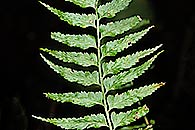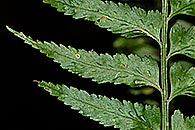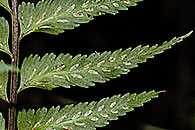Asplenium smedsii Pic. Serm.
Synonyms |
|
|---|---|
Common name |
|
Description |
Rhizome short, erect, rhizome scales chestnut-brown, triangular in outline, apex long tapering to a point, margin entire or fimbriate-lobed, ending in hair-tip, up to 11 × 4 mm. Fronds tufted, thin, erect, olive-green, not proliferous. Stipe matt brown, sometimes green beneath, 8–30 cm long, with dense scales near base, otherwise with scattered narrowly triangular scales to 10 × 3 mm. Lamina elliptic to oblong-elliptic in outline, 18–47 × 7–15(–24) cm, 1-pinnate; lower pinnae slightly smaller, apical pinnae gradually decrescent. Pinnae in 14–24 pairs, equidistant, stalked, triangular or lanceolate-triangular in outline, (2–)4–8(–12)x(0.7–)1.2–1.6 cm, base unequal, the acroscopic base broadly cuneate, the basiscopic base narrowly cuneate-excised, margin deeply serrate with often bifid teeth, apex long-attenuate, glabrous above, sparsely scaly beneath. Rachis brown, with two narrow green lines, with sparse scales. Sori many per pinna, at a 45° angle to the costa, elliptic, 2.5–6 mm long; indusium membranous, entire. |
Notes | Differs from A. boltonii by the fronds non-gemmiferous, abruptly contracted into the terminal pinna, by all the pinnae equidistant to each other, by the triangular rhizome scales, much shorter and broader, here and there toothed or fimbriate, and throughout uniform in structure. |
Derivation | smedsii: named after H. Smeds, who collected many ferns during his travels in south and south-western Ethiopia. |
Habitat | Moist evergreen forest, deep shade, moist upland forest. |
Distribution worldwide | See African distribution. |
Distribution in Africa |
Burundi, Dem. Republic of Congo, Ethiopia, Kenya, Malawi, Rwanda, Sudan and South Sudan, Tanzania , Uganda. |
Growth form |
Epiphytic, lithophytic, terrestrial. |
Literature |
|




